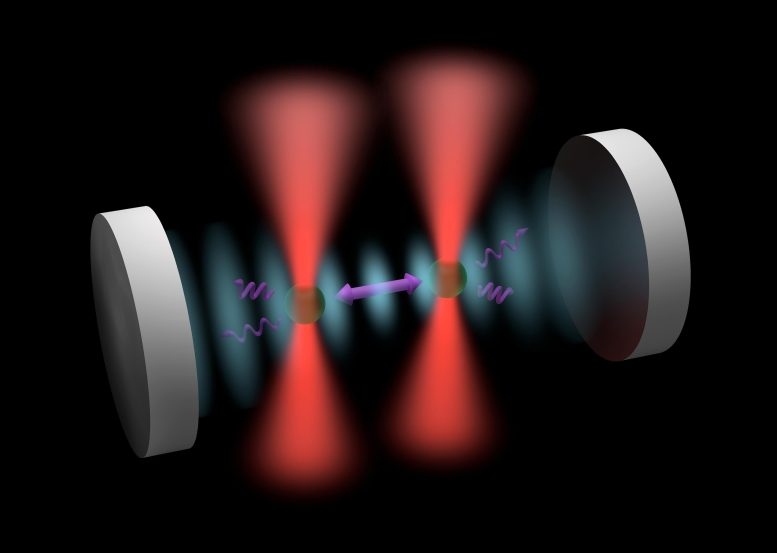
Description: The image shows two nanoparticles (green) trapped by optical tweezers / laser beams (red) and placed in between two mirrors (white) which forms an optical cavity (periodic blue blobs).
The photons scattered by the nanoparticles (squiggly purple arrows) are trapped in the cavity, resulting in an interaction between the two nanoparticles (straight purple line). Credit: The University of Manchester
Innovative research leverages levitated optomechanics to observe quantum phenomena in larger objects, offering potential applications in quantum sensing and bridging the gap between quantum and classical mechanics.
The question of where the boundary between classical and quantum physics lies is one of the longest-standing pursuits of modern scientific research and in new research published today, scientists demonstrate a novel platform that could help us find an answer.
The laws of quantum physics govern the behavior of particles at minuscule scales, leading to phenomena such as quantum entanglement, where the properties of entangled particles become inextricably linked in ways that cannot be explained by classical physics.
Quantum Phenomena in Larger Objects
Research in quantum physics helps us to fill gaps in our knowledge of physics and can give us a more complete picture of reality, but the tiny scales at which quantum systems operate can make them difficult to observe and study.
Over the past century, physicists have successfully observed quantum phenomena in increasingly larger objects, all the way from subatomic particles like electrons to molecules that contain thousands of atoms.
More recently, the field of levitated optomechanics, which deals with the control of high-mass micron-scale objects in vacuum, aims to push the envelope further by testing the validity of quantum phenomena in objects that are several orders of magnitude heavier than atoms and molecules. However, as the mass and size of an object increase, the interactions that result in delicate quantum features, such as entanglement, get lost to the environment, resulting in the classical behavior we observe.
Overcoming Environmental Noise
But now, the team co-led by Dr. Jayadev Vijayan, Head of the Quantum Engineering Lab at The University of Manchester, with scientists from ETH Zurich, and theorists from the University of Innsbruck, have established a new approach to overcome this problem in an experiment carried out at ETH Zurich, published in the journal Nature Physics.
Dr. Vijayan said: “To observe quantum phenomena at larger scales and shed light on the classical-quantum transition, quantum features need to be preserved in the presence of noise from the environment. As you can imagine, there are two ways to do this- one is to suppress the noise, and the second is to boost the quantum features.
“Our research demonstrates a way to tackle the challenge by taking the second approach. We show that the interactions needed for entanglement between two optically trapped 0.1-micron-sized glass particles can be amplified by several orders of magnitude to overcome losses to the environment.”
The scientists placed the particles between two highly reflective mirrors which form an optical cavity. This way, the photons scattered by each particle bounce between the mirrors several thousand times before leaving the cavity, leading to a significantly higher chance of interacting with the other particle.
Johannes Piotrowski, co-lead of the paper from ETH Zurich added: “Remarkably, because the optical interactions are mediated by the cavity, its strength does not decay with distance meaning we could couple micron-scale particles over several millimeters.”
The researchers also demonstrate the remarkable ability to finely adjust or control the interaction strength by varying the laser frequencies and position of the particles within the cavity.
Practical Applications and Future Directions
The findings represent a significant leap toward understanding fundamental physics, but also hold promise for practical applications, particularly in sensor technology that could be used for environmental monitoring and offline navigation.
Dr. Carlos Gonzalez-Ballestero, a collaborator from the Technical University of Vienna said: “The key strength of levitated mechanical sensors is their high mass relative to other quantum systems using sensing. The high mass makes them well-suited for detecting gravitational forces and accelerations, resulting in better sensitivity. As such, quantum sensors can be used in many different applications in various fields, such as monitoring polar ice for climate research and measuring accelerations for navigation purposes.”
Piotrowski added: “It is exciting to work on this relatively new platform and test how far we can push it into the quantum regime.”
Now, the team of researchers will combine the new capabilities with well-established quantum cooling techniques in a stride toward validating quantum entanglement. If successful, achieving the entanglement of levitated nano- and micro-particles could narrow the gap between the quantum world and everyday classical mechanics.
At the Photon Science Institute and the Department of Electrical and Electronic Engineering at The University of Manchester, Dr. Jayadev Vijayan’s team will continue working in levitated optomechanics, harnessing interactions between multiple nanoparticles for applications in quantum sensing.
Reference: “Cavity-mediated long-range interactions in levitated optomechanics” by Jayadev Vijayan, Johannes Piotrowski, Carlos Gonzalez-Ballestero, Kevin Weber, Oriol Romero-Isart and Lukas Novotny, 30 February 2024, Nature Physics.
DOI: 10.1038/s41567-024-02405-3